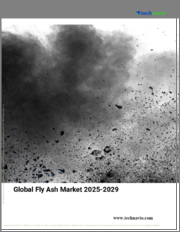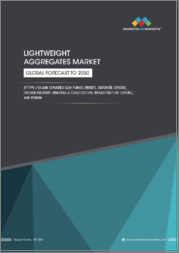
|
시장보고서
상품코드
1485296
플라이애시 시장 : 등급별, 용도별, 예측(2024-2032년)Fly Ash Market - By Class (Class C, Class F), By Application (Cement & Concrete, Bricks & Blocks, Mining, Water Treatment) & Forecast, 2024 - 2032 |
||||||
세계 플라이애시 시장은 2024년부터 2032년까지 연평균 5.2% 이상의 CAGR을 기록할 것으로 예상되며, 이 분야의 연구와 발전에 힘입어 성장세를 이어갈 전망입니다.
산업계가 지속가능성을 중시하고 기존 건설 자재에 대한 대안을 찾는 가운데, 플라이애시는 실행 가능한 솔루션으로 떠오르고 있습니다. 예를 들어, 2024년 4월 필리핀 세부에서 진행된 연구는 시멘트 산업에서 온실가스 배출을 줄이는 기술을 소개했습니다. 필리핀 과학기술부(DOST)의 지원을 받은 이 연구는 시멘트의 일부를 석탄 플라이애시(CFA)로 대체하는 것을 중심으로 진행되었습니다.
현재 진행 중인 연구는 플라이애시의 혁신적인 용도와 처리 기술을 탐구하여 전통적인 시멘트 및 콘크리트 생산 이외의 용도를 확장하고 있습니다. 또한, 플라이애시 선광 기술의 발전은 플라이애시의 품질과 다용도성을 향상시켜 다양한 건설 및 인프라 프로젝트에 적합하게 만들고 있습니다. 환경 문제와 규제 압력이 증가함에 따라 지속가능하고 비용 효율적인 재료로서 플라이애시에 대한 수요는 계속 증가할 것이며, 이 분야의 연구와 기술 혁신을 더욱 촉진할 수 있습니다.
클래스 F 부문은 2024년부터 2032년까지 엄격한 개발이 이루어질 것입니다. 이 종류의 플라이애시는 무연탄 또는 역청탄의 연소로부터 얻어지며 우수한 포졸란 특성을 발휘하여 콘크리트의 내구성과 강도를 향상시킵니다. 건설, 인프라 및 시멘트 부문 산업은 콘크리트 혼합물에서 우수한 성능을 발휘하는 클래스 F 플라이애시에 의존하고 있습니다. 플라이애시의 보급은 지속가능한 건설 관행에서 중요한 구성요소로서의 역할을 강조하며 플라이애시 시장의 안정적인 수요를 주도하고 있습니다.
벽돌 및 블록 분야의 플라이애시 시장 점유율은 2024년에서 2032년 사이에 두드러진 CAGR을 기록할 것입니다. 플라이애시를 벽돌과 블록에 통합하면 강도, 내구성 및 단열성을 향상시킬 수 있습니다. 따라서 주거용, 상업용, 산업용 건물 등 다양한 건축 용도에 적합합니다. 또한, 플라이애시 벽돌과 블록은 재활용 재료를 사용하고 기존 점토 기반 벽돌의 필요성을 줄이기 때문에 환경 친화적입니다. 건설 업계가 지속가능성과 비용 효율성을 우선시함에 따라 벽돌 및 블록 생산에 대한 플라이애시의 수요는 꾸준히 증가하고 있습니다.
아시아태평양 플라이애시 시장은 2024년부터 2032년까지 눈에 띄는 CAGR을 보일 것입니다. 중국, 인도, 동남아시아 국가 등의 급속한 도시화와 인프라 개발 프로젝트는 주요 건설 자재로서 플라이애시의 필요성을 촉진하고 있습니다. 플라이애시는 지속가능하고 비용 효율적인 특성으로 인해 이 지역의 콘크리트 제조, 도로 건설 및 기타 인프라 프로젝트에 널리 사용되고 있습니다. 각국 정부가 지속가능한 개발과 환경 보호를 우선시하는 가운데, 아시아태평양 시장에서 플라이애시에 대한 수요는 건설 산업에서 플라이애시의 필수적인 역할을 반영하여 꾸준히 성장하고 있습니다. 예를 들어, 2023년 5월, 우타르 프라데시 주 동부의 리헨드(Rehind) 및 기타 3개 발전소를 포함한 국영 화력발전공사(NTPC)의 시설들은 종합적인 브랜딩 이니셔티브의 지원을 받아 현재 플라이애시를 이용한 건축 자재 생산에 적극 나서고 있습니다.
목차
제1장 조사 방법과 조사 범위
제2장 주요 요약
제3장 업계 인사이트
- 생태계 분석
- 주요 제조업체
- 유통업체
- 업계 전체의 이익률
- 공급 혼란
- 업계에 대한 영향요인
- 성장 촉진요인
- 시장 과제
- 시장 기회
- 새로운 기회
- 성장 가능성 분석
- 원재료 상황
- 제조 동향
- 기술의 진화
- 지속가능한 제조
- 그린 프랙티스
- 탈탄소화
- 지속가능한 제조
- 원재료의 지속가능성
- 원재료 가격 동향(달러/톤)
- 미국
- 유럽연합
- 영국
- 중국
- 동남아시아
- GCC
- 규제와 시장에 대한 영향
- 무역 통계
- 미충족 수요
- Porters 분석
- PESTEL 분석
제4장 경쟁 상황
- 기업 점유율 분석
- 경쟁 포지셔닝 매트릭스
- 전략 전망 매트릭스
제5장 시장 규모와 예측 : 클래스별, 2018-2032년
- 주요 동향
- C클래스
- F클래스
제6장 시장 규모와 예측 : 용도별, 2018-2032년
- 주요 동향
- 시멘트·콘크리트
- 벽돌과 블록
- 광업
- 수처리
- 기타
제7장 시장 규모와 예측 : 지역별, 2018-2032년
- 주요 동향
- 북미
- 미국
- 캐나다
- 유럽
- 독일
- 영국
- 프랑스
- 이탈리아
- 스페인
- 기타 유럽
- 아시아태평양
- 중국
- 인도
- 일본
- 한국
- 호주
- 기타 아시아태평양
- 라틴아메리카
- 브라질
- 멕시코
- 아르헨티나
- 기타 라틴아메리카
- 중동 및 아프리카
- 사우디아라비아
- 아랍에미리트
- 남아프리카공화국
- 기타 중동 및 아프리카
제8장 기업 개요
- Aggregate Industries
- Ashtech(India) Pvt. Ltd.
- Ashtech Industries
- Boral Resources
- Cemex SAB de CV
- Cement Australia
- Charah Solutions, Inc.
- Headwaters Inc.(Boral Limited)
- LafargeHolcim
- Salt River Materials Group
- SCB International Materials Inc.
- Seperation Technologies LLC
- SEFA Group
- Suyog Suppliers
- Waste Management
Global Fly Ash Market will witness over 5.2% CAGR between 2024 and 2032, driven by rising research and advancements in the field. As industries focus on sustainable practices and seek alternatives to traditional construction materials, fly ash emerges as a viable solution. For instance, in April 2024, a study conducted in Cebu, Philippines, introduced a technique to decrease greenhouse gas emissions within the cement industry. Supported by the Department of Science & Technology (DOST) of the Philippines, the research centered on the partial replacement of cement with coal fly ash (CFA).
Ongoing research efforts explore innovative uses and processing techniques for fly ash, expanding its applications beyond traditional cement and concrete production. Additionally, advancements in fly ash beneficiation technologies enhance its quality and versatility, making it suitable for various construction and infrastructure projects. As environmental concerns and regulatory pressures intensify, the demand for fly ash as a sustainable and cost-effective material could continue growing, driving further research and innovation in the field.
The overall Fly Ash Industry is classified based on the class, application, and region.
The class F segment will undergo rigorous development from 2024 to 2032. This type of fly ash, derived from burning anthracite or bituminous coal, offers excellent pozzolanic properties, enhancing concrete durability and strength. Industries across construction, infrastructure, and cement sectors rely on Class F fly ash for its superior performance in concrete mixtures. Its widespread adoption underscores its role as a key ingredient in sustainable construction practices, driving steady demand in the Fly Ash Market.
The fly ash market share from the bricks and blocks segment will register a notable CAGR from 2024 to 2032. Incorporating fly ash into bricks and blocks enhances their strength, durability, and thermal insulation properties. This makes them ideal for various construction applications, including residential, commercial, and industrial buildings. Additionally, fly ash bricks and blocks are environmentally friendly, as they utilize recycled material and reduce the need for traditional clay-based bricks. As construction industries prioritize sustainability and cost-effectiveness, the demand for fly ash in brick and block manufacturing continues to rise steadily.
Asia Pacific fly ash market will showcase a commendable CAGR from 2024 to 2032. Rapid urbanization and infrastructure development projects across countries like China, India, and Southeast Asian nations drive the need for fly ash as a key construction material. With its sustainable and cost-effective properties, fly ash is widely utilized in concrete production, road construction, and other infrastructure projects in the region. As governments prioritize sustainable development and environmental protection, the demand for fly ash in the Asia Pacific market continues to grow steadily, reflecting its integral role in the construction industry. For instance, in May 2023, The National Thermal Power Corporation (NTPC) facilities, including Rihand and three other units in eastern Uttar Pradesh, were now actively engaged in manufacturing building materials using fly ash, supported by a comprehensive branding initiative.
Table of Contents
Chapter 1 Methodology & Scope
- 1.1 Market scope & definition
- 1.2 Base estimates & calculations
- 1.3 Forecast calculation
- 1.4 Data sources
- 1.4.1 Primary
- 1.4.2 Secondary
- 1.4.2.1 Paid sources
- 1.4.2.2 Public sources
Chapter 2 Executive Summary
- 2.1 Industry 360 degree synopsis
Chapter 3 Industry Insights
- 3.1 Industry ecosystem analysis
- 3.1.1 Key manufacturers
- 3.1.2 Distributors
- 3.1.3 Profit margins across the industry
- 3.1.4 Supply disruptions
- 3.2 Industry impact forces
- 3.2.1 Growth drivers
- 3.2.2 Market challenges
- 3.2.3 Market opportunity
- 3.2.3.1 New opportunities
- 3.2.3.2 Growth potential analysis
- 3.3 Raw material landscape
- 3.3.1 Manufacturing trends
- 3.3.2 Technology evolution
- 3.3.2.1 Sustainable manufacturing
- 3.3.2.1.1 Green practices
- 3.3.2.1.2 Decarbonization
- 3.3.2.1 Sustainable manufacturing
- 3.3.3 Sustainability in raw materials
- 3.3.4 Raw material pricing trends (USD/Ton)
- 3.3.4.1 U.S.
- 3.3.4.2 European Union
- 3.3.4.3 UK
- 3.3.4.4 China
- 3.3.4.5 Southeast Asia
- 3.3.4.6 GCC
- 3.4 Regulations & market impact
- 3.5 Trade statistics
- 3.6 Unmet needs
- 3.7 Porter's analysis
- 3.8 PESTEL analysis
Chapter 4 Competitive Landscape, 2023
- 4.1 Company market share analysis
- 4.2 Competitive positioning matrix
- 4.3 Strategic outlook matrix
Chapter 5 Market Size and Forecast, By Class, 2018-2032 (USD Billion, Kilo Tons)
- 5.1 Key trends
- 5.2 Class C
- 5.3 Class F
Chapter 6 Market Size and Forecast, By Application, 2018-2032 (USD Billion, Kilo Tons)
- 6.1 Key trends
- 6.2 Cement and concrete
- 6.3 Bricks and blocks
- 6.4 Mining
- 6.5 Water treatment
- 6.6 Others
Chapter 7 Market Size and Forecast, By Region, 2018-2032 (USD Billion, Kilo Tons)
- 7.1 Key trends
- 7.2 North America
- 7.2.1 U.S.
- 7.2.2 Canada
- 7.3 Europe
- 7.3.1 Germany
- 7.3.2 UK
- 7.3.3 France
- 7.3.4 Italy
- 7.3.5 Spain
- 7.3.6 Rest of Europe
- 7.4 Asia Pacific
- 7.4.1 China
- 7.4.2 India
- 7.4.3 Japan
- 7.4.4 South Korea
- 7.4.5 Australia
- 7.4.6 Rest of Asia Pacific
- 7.5 Latin America
- 7.5.1 Brazil
- 7.5.2 Mexico
- 7.5.3 Argentina
- 7.5.4 Rest of Latin America
- 7.6 MEA
- 7.6.1 Saudi Arabia
- 7.6.2 UAE
- 7.6.3 South Africa
- 7.6.4 Rest of MEA
Chapter 8 Company Profiles
- 8.1 Aggregate Industries
- 8.2 Ashtech (India) Pvt. Ltd.
- 8.3 Ashtech Industries
- 8.4 Boral Resources
- 8.5 Cemex SAB de CV
- 8.6 Cement Australia
- 8.7 Charah Solutions, Inc.
- 8.8 Headwaters Inc. (Boral Limited)
- 8.9 LafargeHolcim
- 8.10 Salt River Materials Group
- 8.11 SCB International Materials Inc.
- 8.12 Seperation Technologies LLC
- 8.13 SEFA Group
- 8.14 Suyog Suppliers
- 8.15 Waste Management



















